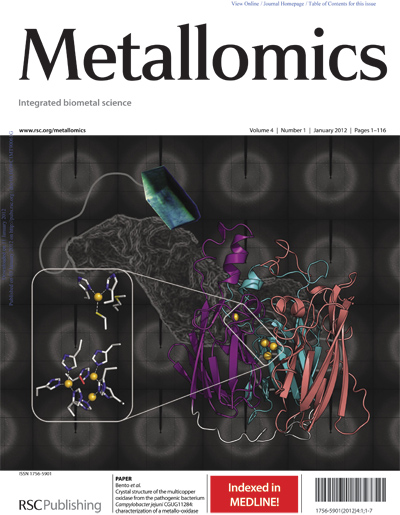Regulating metals inside the cell
Oeiras, 11.01.12
By unravelling its 3D structure, ITQB researchers from the Macromolecular Crystallography Unit and the Microbial & Enzyme Technology Laboratory show how the enzyme McoC contributes to maintain the proper levels of metals inside the pathogenic bacteria Campylobacter jejuni, the major culprit of common gastroenteritis. The findings are highlighted on the cover of the January issue of Metallomics.
Metal homeostasis is essential for a number of life processes, including infection. In Campylobacter jejuni, this process is associated with the activity of a particular multicopper oxidase enzyme that oxidises copper with higher efficiency instead of the more general role for these enzymes as oxidisers of aromatic substrates, such as phenolics and aromatic compounds. After a painstaking and long period of experimental work, researchers were finally able to obtain the necessary protein crystals and determine the corresponding structure of the enzyme, opening the way for understanding its mechanism.
The crystal structure determination of the recombinant McoC together with its spectroscopic, biochemical and enzymatic characterization suggest that McoC may act as a metallo-oxidase also in vivo, playing a protective role while scavenging metallic ions into their less toxic form and also inhibiting the formation of radical oxygen species.
Original Article:
Metallomics, 2012, 4 (1), 37 – 47 | DOI: 10.1039/C1MT00156F
Crystal structure of the multicopper oxidase from the pathogenic bacterium Campylobacter jejuni CGUG11284: characterization of a metallo-oxidase
Catarina S. Silva, Paulo Durão, Amanda Fillat, Peter F. Lindley, Lígia O. Martins and Isabel Bento
Journal Cover:
| Multicopper oxidases are a multi-domain family of enzymes that are able to couple oxidation of substrates with reduction of dioxygen to water. These enzymes are capable of oxidizing a vast range of substrates, varying from aromatic to inorganic compounds such as metals. This metallo-oxidase activity observed in several members of this family has been linked to mechanisms of homeostasis in different organisms. Recently, a periplasmic multicopper oxidase, encoded by Campylobacter jejuni, has been characterised and associated with copper homeostasis and with the protection against oxidative stress as it may scavenge metallic ions into their less toxic form and also inhibit the formation of radical oxygen species. In order to contribute to the understanding of its functional role, the crystal structure of the recombinant McoC (Campylobacter jejuni CGUG11284) has been determined at 1.95 Å resolution and its structural and biochemical characterizations undertaken. The results obtained indicate that McoC has the characteristic fold of a laccase having, besides the catalytic centres, another putative binding site for metals. Indeed, its biochemical and enzymatic characterization shows that McoC is essentially a metallo-oxidase, showing low enzymatic efficiency towards phenolic substrates. |








